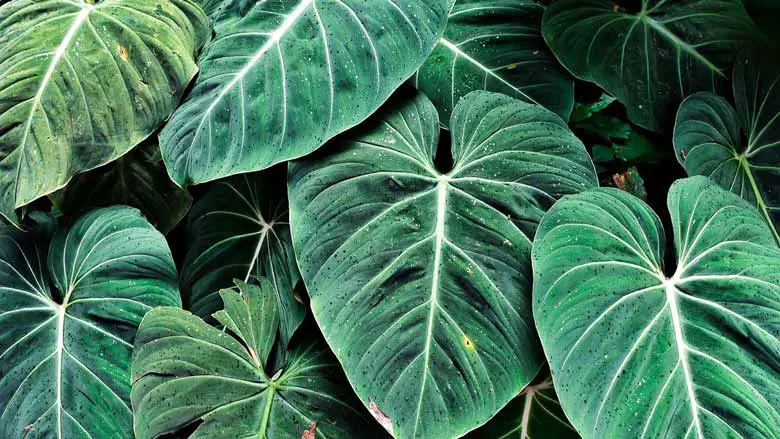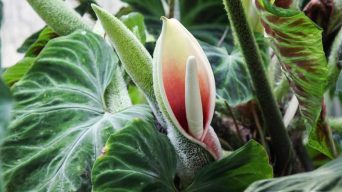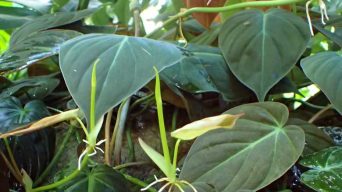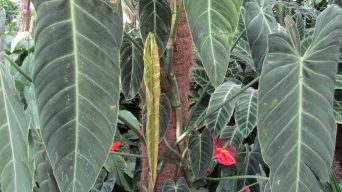Growing Philodendron gloriosum plants is easy, and they are very versatile houseplants.
They can be grown in various indoor environments, from low to bright light, making them perfect for beginners and experienced gardeners.
Philodendron gloriosum care is simple.
These plants are tolerant of many growing conditions and can be easily propagated from stem cuttings.
Here is a complete guide on how to care for and propagate Philodendron gloriosum plants.
Philodendron Gloriosum Overview
| Family: | Araceae |
| Genus: | Philodendron |
| Botanical Name: | Philodendron gloriosum |
| Synonyms: | Anthurium gloriosum |
| Common Names: | Velvet Philodendron, Creeper Plant |
| Origin: | Colombia |
| USDA Hardiness Zones: | 11 – 12 |
| Size: | 2.5 feet (76cm) tall |
| Sun Exposure: | Bright, indirect sunlight |
| Water Needs: | Water thoroughly but infrequently |
| Soil Type: | Well-draining soil |
| Temperature: | Between 65 and 80 degrees Fahrenheit (18 – 26°C) |
| Humidity Levels: | 60-80% |
The Philodendron gloriosum plant is a beautiful Philodendron species native to Colombia.
It is a member of the Araceae family and is also known by the common names:
- Philodendron gloriosum André
- Anthurium gloriosum
- Velvet Philodendron
- Creeper Plant
- Crawling Philodendron
- Gloriosum Philodendron
It is an evergreen climber that can reach up to 2.5 feet in length.
The leaves are large and glossy, with a deep green coloration and a velvety texture.
They have deeply white-lobed margins and can grow up to 36 inches.
The P. gloriosum is known to only bloom in its natural habitat.
The flowers are white, small, and inconspicuous, borne on a spadix surrounded by a large, glossy bract.
Philodendron gloriosum is a widely cultivated plant commonly used as a houseplant or as part of an ornamental landscaping design.
How To Care for Philodendron Gloriosum
Philodendron gloriosum is a slow-growing plant that is relatively easy to care for.
It can be grown in a wide range of indoor environments, from low light to bright light.
Philodendron gloriosum plant care is similar to that of other philodendron species.
Here is a complete guide to caring for Philodendron gloriosum.
Sun Exposure & Light Requirements
Philodendron gloriosum enjoys bright indirect light.
If you live in a mainly sunny climate, you may need to provide dappled shade during the day’s hottest hours.
When it comes to sun exposure, too much of a good thing can harm your plant.
Too much direct sunlight can cause the leaves to scorch and turn brown. If you notice this, move your plant to a spot with less direct sunlight.
When grown as an indoor plant, philodendron gloriosum will do best near an east- or west-facing window. This will provide the bright, indirect light that the plant needs without exposing it to too much direct sunlight.
When growing philodendron gloriosum outdoors, choose a spot that receives bright, indirect light. This could be beneath the canopy of a tree or next to a building.
They need at least 4 hours of bright light each day to maintain their vibrant leaf color.
However, the Philodendron leaves will develop brown spots if the light is too strong.
Watering Requirements
The Philodendron gloriosum is a tropical plant requiring more water than your average houseplant.
However, that doesn’t mean you should water it every day.
You should generally water your Philodendron gloriosum about once or twice a week or when the top inch of soil is dry.
Although, if you live in a particularly hot or humid climate, your plant may require more water.
During the winter months, you can reduce your watering schedule to once every two weeks.
When watering your Philodendron gloriosum, use lukewarm water and avoid getting the leaves wet, as this can cause leaf spot.
Water the plant thoroughly until water runs out of the drainage holes at the bottom of the pot.
Don’t let the plant sit in water, which can lead to root rot.
Philodendron gloriosum plants are also quite sensitive to fluoride, so if your tap water is high in fluoride, it’s best to use filtered or distilled water.
Soil Requirements
The Philodendron gloriosum requires a loose, well-draining soil mix.
A bark-based potting mix with perlite or vermiculite added for drainage works well.
You can also mix your own soil by mixing equal parts potting soil, sphagnum peat moss, perlite, and orchid bark.
Sphagnum peat moss helps retain moisture, while perlite and orchid bark provide good drainage.
It is important to note that the roots of this plant are very fragile and can easily be damaged. For this reason, it is best to avoid using a potting mix containing large chunks of gravel.
Temperature and Humidity
In its natural habitat, Philodendron Gloriosum grows in hot and humid conditions.
It is, therefore, essential to recreate these conditions when growing the plant indoors.
The plant prefers temperatures between 65 and 80 degrees Fahrenheit (18 – 26°C) and high humidity levels of around 60-80%.
If the temperature or humidity levels drop too low, the Philodendron leaves will start to brown and drop off.
To increase the humidity around your Philodendron Gloriosum, you can do one or more of the following:
- Group your plants: By grouping plants together, they can help to increase the humidity around each other.
- Use a humidifier: This is often the easiest way to increase the humidity, especially if you have more than one plant.
- Use a pebble tray: Place a layer of pebbles or gravel in a tray and add water just below the top of the stones. Place your Philodendron on top of the pebbles. The water will evaporate and increase the humidity around the plant.
- Mist your plant: Misting your Philodendron regularly with water will also help to increase the humidity. Just be sure not to mist the leaves too much, as this can cause them to rot.
Fertilizing
Philodendron gloriosum should be fertilized regularly during its growing season, spring and summer.
Fertilize every two weeks with a half-strength fertilizer solution.
Dilute the fertilizer to half the recommended concentration and apply it to the soil around the plant.
Refrain from fertilizing during the fall and winter when the plant is dormant.
When you observe the leaves changing to a yellow hue, it’s an indication that you might be using too much fertilizer.
Cut back on fertilizer and flush the potting mix with clean water to remove excess fertilizer salts.
Potting and Repotting
Philodendron gloriosum does best in a pot that is only slightly larger than the current one it is in. This allows the roots to stay snug and not become rootbound too quickly.
Repot every 18 months to 2 years using a good quality potting mix.
Repotting in fresh soil will give your plant the nutrients it needs to grow well.
The best time to repot is in spring or early summer.
A glazed ceramic pot is a good option for this plant as it will help keep the roots cooler and prevent the soil from drying out too quickly.
Be sure to choose a pot with drainage holes to allow excess water to escape.
When repotting, be very careful of the plant’s fragile roots.
Gently loosen the root ball and remove any old potting mix before placing it in the new pot.
Backfill with potting mix, being sure to firm it around the roots. Don’t water for a few days to allow the roots to settle in.
Pruning
Pruning is an essential part of philodendron gloriosum care. This plant can become quite leggy and sparse over time, so regular pruning is necessary to keep it looking its best
It not only helps to keep the plant looking tidy but also encourages new growth.
When pruning, be sure to use sharp, clean scissors or shears.
Sterilize them first with rubbing alcohol to prevent the spread of disease.
Cut back leggy stems to the desired length, leaving at least 2-3 leaves on each stem.
You can also remove brown or yellow leaves and dead flower clusters.
Cut the stem to just above a leaf node (the point where leaves emerge from the stem). This will encourage new growth to emerge from that point. You can also cut back leggy stems to the soil line if desired.
If you want to encourage bushier growth, you can prune the tips of the stems.
Just be sure not to cut too much, as this can damage the plant.
Pruning is best done in the spring or summer when the plant is actively growing.
However, you can prune at any time if necessary.
Remember that the plant may recover slowly from winter pruning.
Pests
Philodendron gloriosum plants are not known to be particularly susceptible to pests. Still, like all plants, they can fall victim to mealybugs, aphids, spider mites, or scale.
Mealybugs are small, white, fuzzy insects congregating on new growth and under leaves.
They suck the sap from the plant, causing leaves to yellow and wilt.
You can tell if your plant has mealybugs if you see tiny, white bugs or if there is a sticky substance (honeydew) on the leaves.
Aphids are tiny green or black insects that cluster on the undersides of leaves and stems.
They, too, suck the sap from the plant, causing leaves to turn yellow and wilt.
You can tell if your plant has aphids by looking for small, black, or green insects on the undersides of the leaves.
Spider mites are tiny, red or brown insects that spin webs on the undersides of leaves.
They feed on the plant’s sap, causing Philodendron leaves to turn yellow and eventually drop off.
You can tell if your plant has spider mites if you see tiny red or brown insects on the undersides of the leaves or if there is a fine webbing.
Scale insects are small, brown insects that attach themselves to the stems of plants.
They suck the sap from the plant, causing leaves to yellow and wilt.
You can tell if your plant has scale insects by looking for small, brown bumps on the stems.
If you think your plant has pests, it is best to isolate it from other plants and inspect it closely.
If you see any bugs, you can remove them by hand or with a cotton swab dipped in rubbing alcohol.
You can also treat the plant with insecticidal soap or neem oil.
Diseases
Philodendron gloriosum plants are generally disease-free.
However, they may be susceptible to fungal diseases such as powdery mildew and root rot if they are not cared for properly.
Powdery mildew is a white, powdery fungus that can form on the Philodendron gloriosum leaves.
This disease is most commonly found in humid or overly wet conditions.
To prevent powdery mildew, ensure good air circulation around your plant and water it at the base of the plant rather than from above.
Root rot is another fungal disease that can affect philodendron plants.
This disease is caused by too much water and can lead to the plant’s roots rotting away.
If you think your philodendron plant may have root rot, check the roots for signs of browning or decay.
To prevent root rot, plant your Philodendron in well-draining soil and water it only when the top inch of the soil is dry.
How to Care for Philodendron Gloriosum in Winter
When the weather outside is frightful, your Philodendron gloriosum plant doesn’t have to be.
This South American native is well-suited to life as a houseplant, tolerating less-than-ideal indoor conditions with grace.
Providing your Philodendron gloriosum with the proper care during winter will reward you with lush, green growth come spring.
The following tips will help you care for your Philodendron gloriosum during the winter months:
- Provide bright indirect light. Philodendron gloriosum does best in bright indirect sunlight. If your home is darker during winter, consider placing your plant near a south- or west-facing window.
- Allow the soil to dry out between waterings. This plant is tolerant of drought, so err on underwatering rather than overwatering. Water your Philodendron gloriosum only when the top inch or two of soil is dry.
- Increase humidity. Philodendron gloriosum thrives in humid conditions, so consider running a humidifier near your plant or placing it on a pebble tray.
- Avoid drastic temperature changes. Sudden temperature changes can stress your plant and cause leaf drop, so keep your Philodendron gloriosum away from drafty windows and doors.
- Don’t fertilize. This is the time of year to give your Philodendron gloriosum a rest from fertilizing. Resume regular fertilization in spring, when new growth begins.
- Bring your plant indoors. If you live in an area that experiences freezing temperatures in winter, it’s best to bring your Philodendron gloriosum indoors until the danger of frost has passed.
You can keep your Philodendron gloriosum healthy and happy all winter long with extra care.
How To Propagate Philodendron Gloriosum
Philodendron gloriosum propagation is a straightforward process that can be done by stem cuttings.
You can use two methods for propagating philodendron plants: water and soil.
Water Propagation
Propagating Philodendron plants in water is the easiest method, requiring the least effort.
To propagate Philodendron gloriosum in water, follow these steps:
- Cut a 4-6 inch (10-15 cm) stem from the mother plant, including at least 2 leaves. Cut just below a node (the point on the stem where leaves emerge).
- Remove the bottom leaves from the stem, leaving only 2-3 leaves at the top.
- Fill a jar or glass with water and place the stem in the water.
- Place the jar or glass in a bright, indirect light source and wait for roots to form. This can take anywhere from 2-8 weeks.
- Once roots have formed, you can either pot the plant in soil or grow it in water.
- To pot the plant in soil, fill a pot with a well-draining potting mix and carefully transfer the plant, making sure not to damage the roots.
- Water the plant and place it in a bright, indirect light source.
When propagating a philodendron plant in water, it’s essential to change the water every week to prevent bacteria from build-up.
Soil Propagation
Propagating Philodendron gloriosum in the soil is more involved than propagating in water, but you can do it successfully.
To propagate Philodendron gloriosum in soil, follow these steps:
- Cut a 4-6 inch (10-15 cm) stem from the mother plant, including at least 2 leaves. Cut just below a node (the point on the stem where leaves emerge).
- Remove the bottom leaves from the stem, leaving only 2-3 leaves at the top.
- Dip the cut end of the stem in rooting hormone.
- Fill a pot with well-draining potting soil mix and make a hole in the center of the pot.
- Carefully insert the stem into the hole, ensuring the leaves are above the potting mix.
- Water the plant and place it in a bright, indirect light source.
- Keep the potting soil mix moist but not wet, and wait for roots to form. This can take anywhere from 2-8 weeks.
- Once roots have formed, pot the plant in a larger pot with a well-draining potting mix.
- Water the plant and place it in a bright, indirect light source.
When propagating philodendron plants in soil, it’s essential to use a well-draining potting mix and regularly water the plant.
Overwatering can cause the roots to rot, so allow the potting mix to dry out slightly between watering.
Final Thoughts
Growing the Philodendron gloriosum is not tricky, but it does require some care and attention.
However, the rewards are worth the effort, as this stunning plant is stunning.
With its magnificent leaves and trailing habits, it can make a statement in any home or office.







